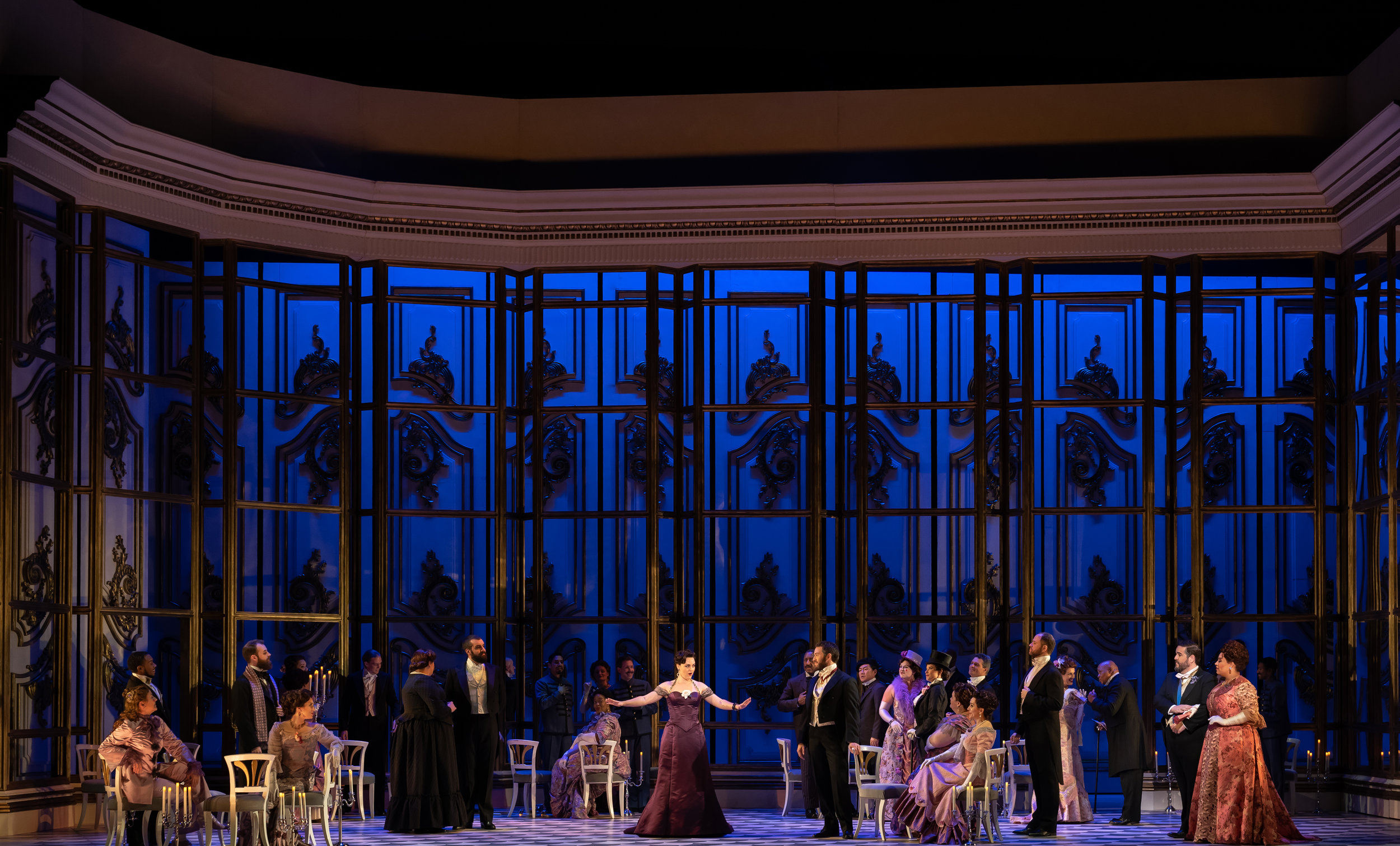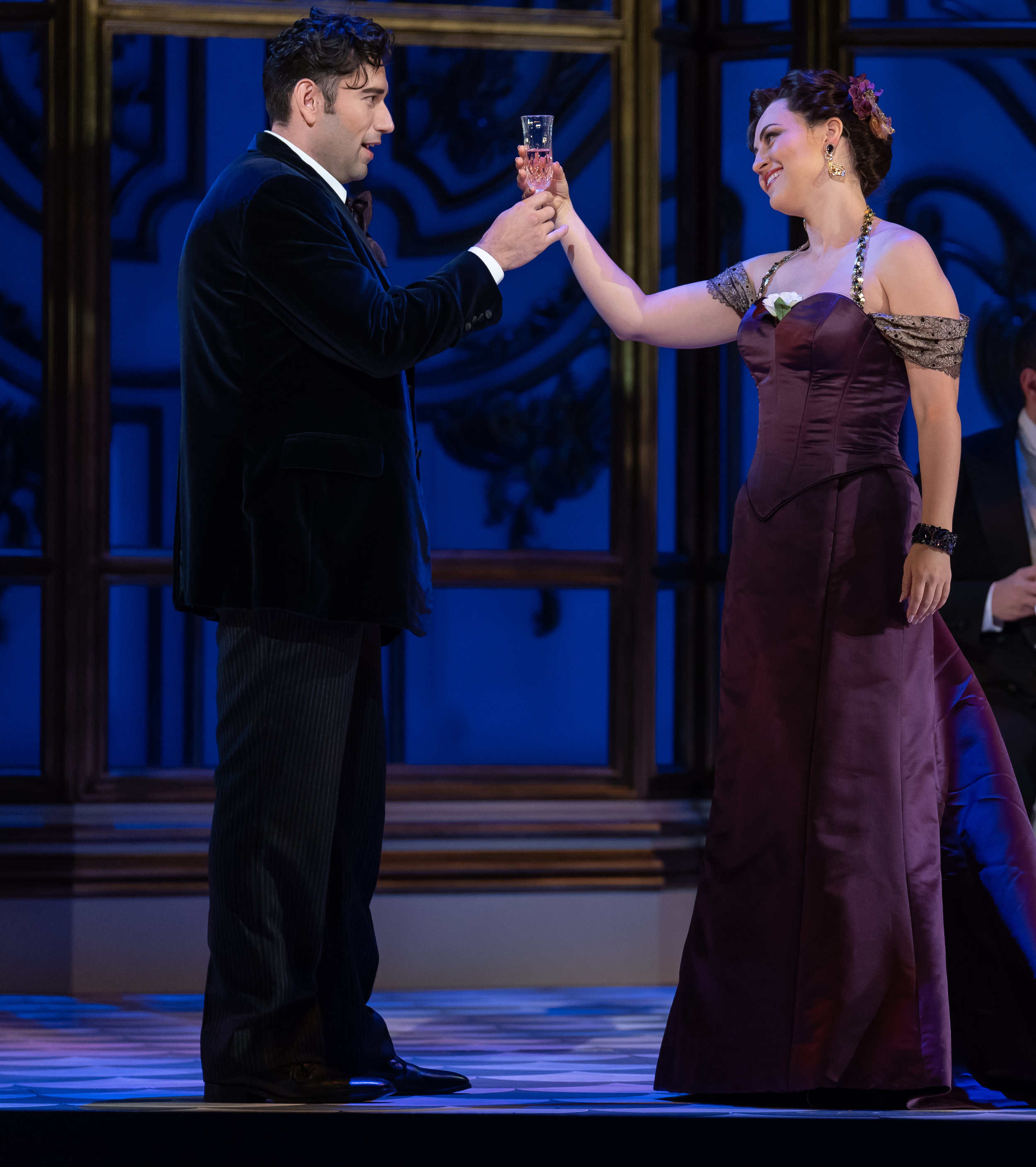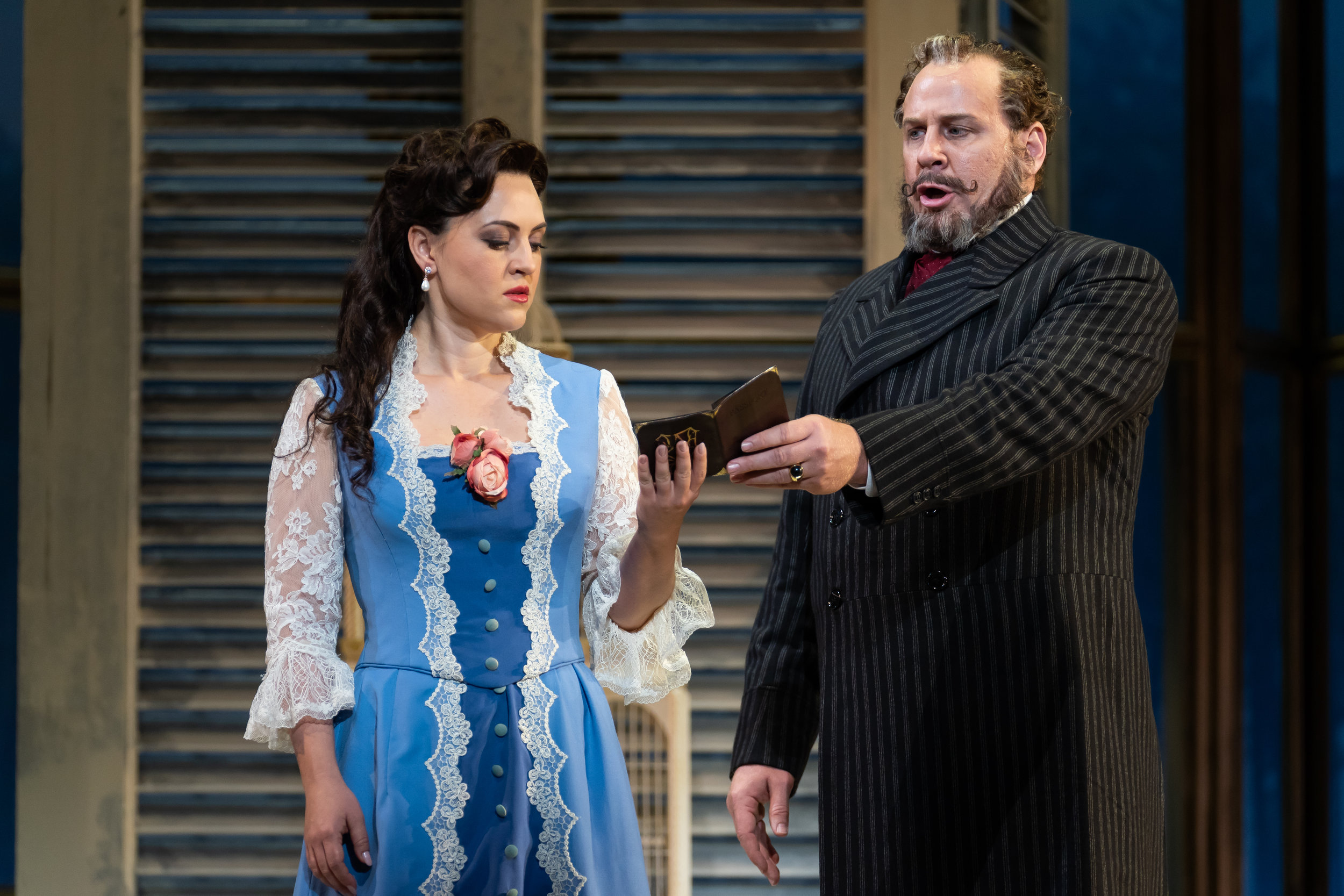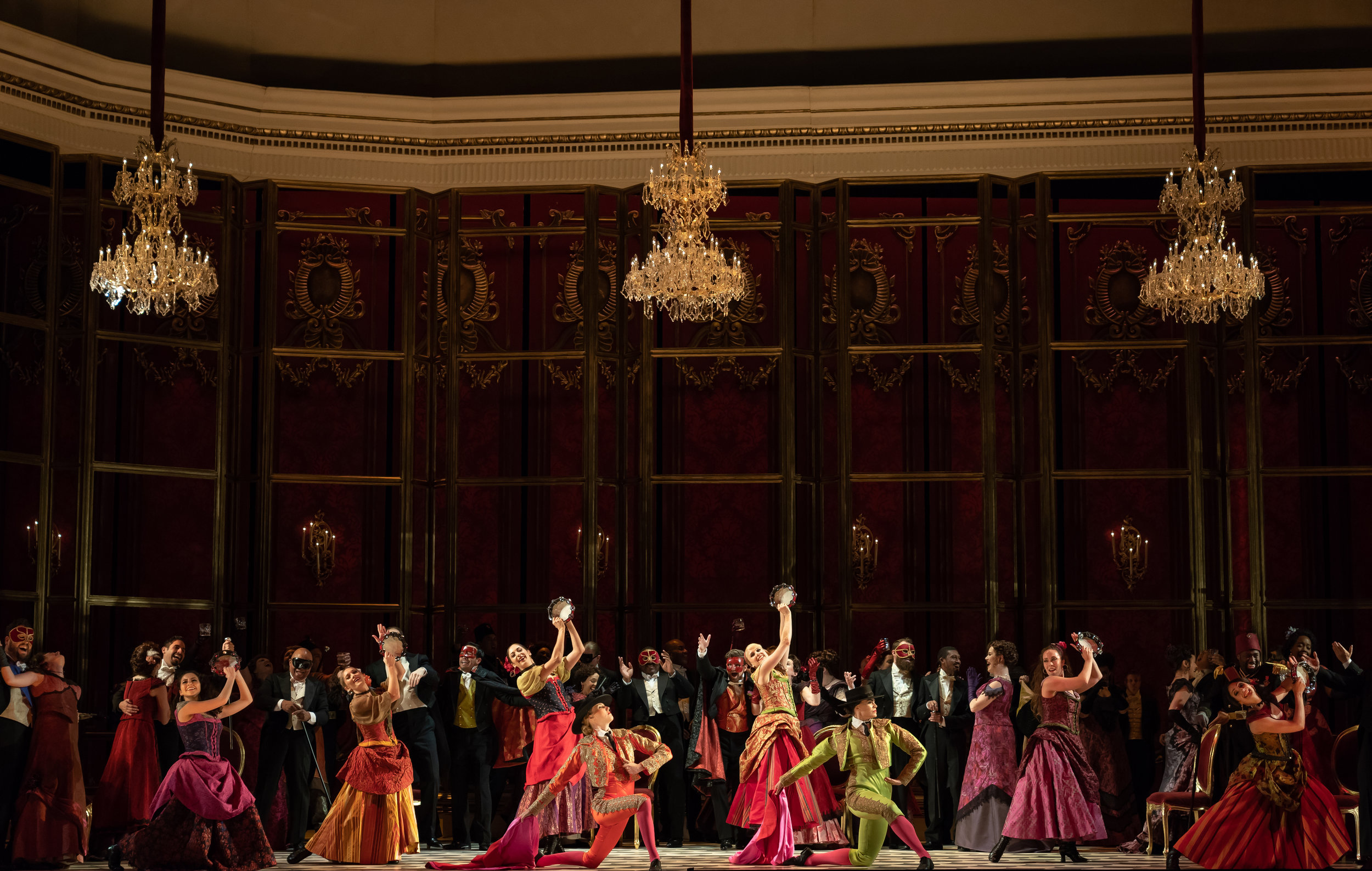WNO began a two-week run on Saturday night of its new production of La Traviata by composer Giuseppe Verdi and librettist Francesco Maria Piave. This opera, this season alone, is scheduled for 459 performances across the globe; it has been performed since 1853. It is fair to ask why do we the opera going public keep going to see this opera, and thereby cause opera companies to keep putting it on their schedules? It looked like a full house on Saturday night. Admittedly, it is a great story taken from the play La Dame aux Camélias (1852) written by Alexandre Dumas fils (son of the famous author, Alexandre Dumas pére – think The Three Musketeers and The Count of Monte Cristo). The play was inspired by the life of a real-life Parisian courtesan, Marie Duplessis, who died of consumption and with whom Dumas, the son, had had a non-exclusive liaison that lasted a little under a year. La Traviata is said to be Verdi’s most realistic opera.
The party begins with Violetta (Venera Gimadieva) the center of attention. Photo by Scott Suchman; courtesy of the Washington Natonal Opera.
Italian opera authority David Kimbell has stated that La Traviata is based on “a single moral idea – that of an ideal of love which survives all man’s attempts to exploit and corrupt it.” Violetta is a beautiful Parisian courtesan in the 18th century who has chosen a life of pleasure, quite successfully so, while sacrificing her reputation in polite society. She is in fact a well-paid sex worker in her early twenties, but she is also brilliant, graceful, and charming, qualities that cause her to be adored by those in polite society who come out at night. She is well aware of the costs of her chosen path (la traviata translates as one who has gone astray, i.e., a fallen woman), but she prefers this life to the pain and weariness that the world lavishes on those who choose more acceptable professions. She has developed consumption, almost always fatal in that era. At one of the salon parties she meets Alfredo Germont, a young man from a respectable, well-to-do family. He has fallen in love with her and his words stir a secret desire within her to love and be loved. They live happily together for a short time in the country side before Alfredo’s father, Giorgio Germont, appears to plead in private with her to release his son to allow Alfredo to live a respectable life and allow his sister to marry into a respectable family. Violetta, at great personal suffering, summons the will to do the honorable thing, and in the only way possible, by returning to her former life. Alfredo, who believes her act, angrily insults her in public before departing with his father. Later, the father, stricken by guilt, confesses to Alfredo, and the lovers are reunited, moments before she dies.
left: Joshua Guerrero as Alfredo Germont and Venera Gimadieva as Violetta. right: Venera Gimadieva as Violetta and Lucas Meachem as Giorgio Germont. Photo by Scott Suchman; courtesy of the Washington National Opera.
Terrific stuff, but how many times do you want to hear the same great story? Honestly, I attended WNO’s new production of La Traviata on Saturday night largely because that is what was showing. The chance to hear Verdi’s music and its incomparable arias sung by a cast of highly-regarded singers made my decision more palatable. I was also curious to see what this new production by Director Francesca Zambello would be like; she is also WNO’s artistic director.
There were two stars to the evening: as anticipated, soprano Venera Gimadieva, making her first U.S. appearance, and Ms. Zambello, who breathed new life into this oft told tale. The opera very much lives or dies based upon how convincing and compelling the soprano who plays Violetta can be, and Ms. Gimadieva gave us an excellent performance. I was not sure this was going to be the case early in Act I, but by the close of the first act, the warmth and beauty of her voice was in full radiance. It is worth going to see and hear her Violetta. On the other hand, I personally did not care for tenor Joshua Guerrero’s portrayal of Alfredo, neither singing nor acting; he was not convincing or compelling to me (in fairness, both my wife and son thought he was a good Alfredo). I had mixed feelings about Lucas Meachem who plays Germont, the father. He has a commanding baritone voice to go along with a commanding stage presence. His portrayal of Germont senior was convincing, though stoic, perhaps to a fault. I thought he shone best in his scenes with his son as more human, rather than with Violetta. Several of the minor roles were well played by current or former Domingo-Cafritz young artists, including mezzo-soprano Deborah Nansteel as salon proprietor Flora, tenor Arnold Livingston Geis as Gaston, Alfredo’s friend, soprano Alexandra Shiner as nurse Annina, and bass Timothy Bruno as Dr. Grenvil. The orchestra led by Conductor Renato Palumbo must have played well considering how much I enjoyed the arias. However, when I focused on the orchestra, it seemed to vary between almost disappearing and then charging in like the calvary; it seemed uneven to me. The chorus under the direction of Chorus Master Steven Gathman added enjoyment to the evening, especially when singing in smaller groupings and using softer tones.
left: Arnold Livingston Geis as Gastone and Deborah Nansteel as Flora partying. right: Spanish dancers enliven the party. Photo by Scott Suchman; courtesy of the Washington National Opera.
The other star of the night was Director Francesca Zambello. There are features of her new production to take issue with, but on the whole, this was WNO’s turn at making opera fun by giving the audience something fresh and different, visually arresting. For me, it did not succeed as well at fully drawing me into the drama, but did well enough. The focus seemed to be on the show, the costumes, the sets, the lighting, and the dancing. All were, in fact, stunning. The nineteenth century costumes were beautiful, the sets were eye pleasing with a depth and perspective supported by lighting effects that made the scenery both attractive and convincing. The dancers in colorful costumes showed enthusiasm and fire; though, while delightful, the dance number leading off Act II seemed gratuitous. Kudos to Costume Designer Jess Goldstein, Set Designer Peter Davidson, Lighting Designer Mark McCollough, and Choreographer Parker Esse. Ms. Zambello began with the ending with Violetta in a hospital bed as Verdi’s overture played; the overture is sad for about thirty seconds and then becomes more lively dissociating from the action on stage. This was saved somewhat by Violetta bouncing out of bed revealing her party dress and off she went, though that did not seem like someone gravely ill. There was another such moment at the opera’s close when Violetta imitates Tosca, but hey, adding something unexpected to refresh this opera is not a bad thing. The symbolism of having Germont entertain himself with birds in a cage and then pluck petals from a flower as he pleaded with Violetta were double edged as changes tend to be; they made him seem unconcerned with Violetta’s feelings, but then it was harder to believe his conversion in the end. Overall, staging got an A from me for making something old new.
Alfredo (Joshua Guerrero) comforts Violetta (Venera Gimadieva) in her final moments. Photo by Scott Suchman; courtesy of the Washington National Opera.
So, why do we keep going back to La Traviata? We keep going back to our favorite restaurant for our favorite dish for both the pleasure and the nourishment. La Traviata pleases, especially in sparkling productions such as this one, but what does it nourish? I often try to put into words what the arts give us that keeps us going back, even for the same thing, and I consistently feel I come up short. I recently read this quote by Ned Rorem, “If music could be translated into human speech, it would no longer need to exist.” Maybe, this is the case for the arts in general. As one of my favorite comedians says, “I can’t tell you why, I just know it’s true.”
The Fan Experience: Future performances by the Gimadieva-Guerrero-Meachem cast will be on Oct 9, 11, 13, 15, 17, 21. The Jacqueline Echols – Mario Chang – Michael Chioidi cast will perform on Oct 14, 20. There will be one performance on Oct 19 by the Domingo-Cafritz Young Artists. Tickets can be accessed here.
My son and I took the Silver Line Metro to Foggy Bottom and walked to the Kennedy Center. It took about 8 min to walk. The red Kennedy Center shuttle bus waiting at the metro stop left the station after we did and it beat us there by about 3 minutes. As we were speeding down the middle of I-66 on the subway, I felt sympathy for the folks in the cars fighting the congestion.






